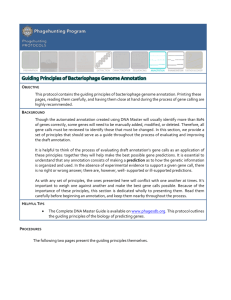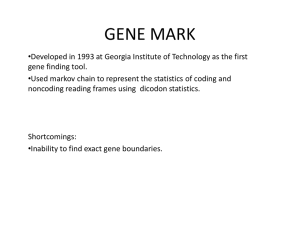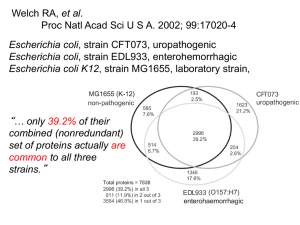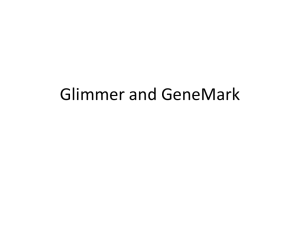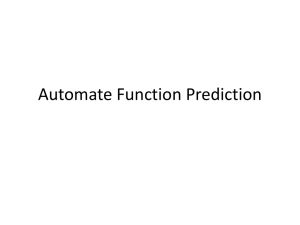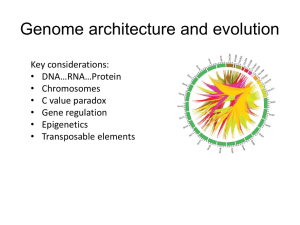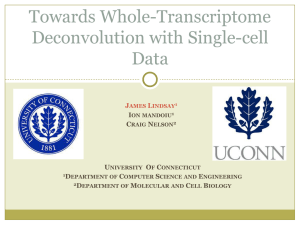Intrdouction to Annotation (djs)
advertisement
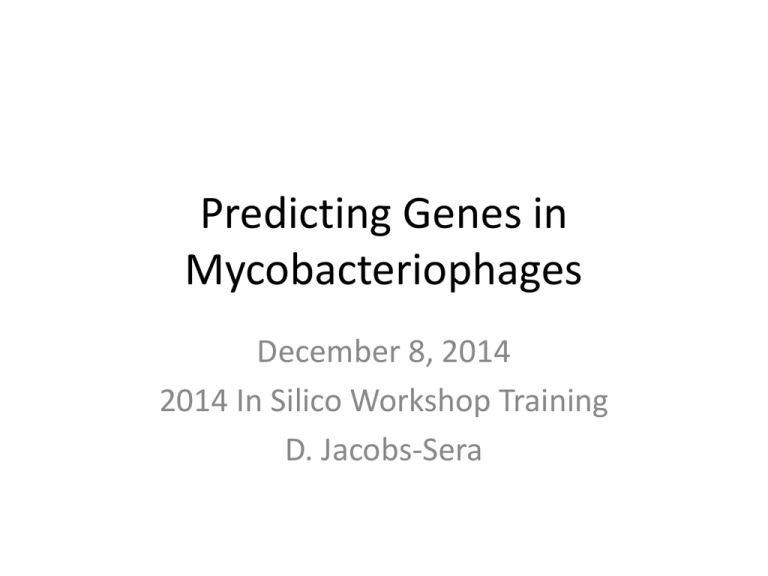
Predicting Genes in Mycobacteriophages December 8, 2014 2014 In Silico Workshop Training D. Jacobs-Sera It is all about finding the patterns… Since the beginning of time, woman (being human) has tried to make order and sense out of her surroundings. Gene annotation and analysis is just a primal instinct to make order. Young children, as they prepare to enter school, are tested to see if they are ready by recognizing patterns, a form of making order. 1. Where will the dot appear in the 4th box? Remember, everything you need to know, you learned in kindergarten…. Make-Believe or Putative Remember, you are working in the putative gene world. All gene predictions are made with the best evidence to date. Most of that evidence is computational (bioinformatic), not experimental. Tomorrow’s data may give us better evidence, but your prediction today is the best it can be … today! Make good predictions following a consistent approach. Let these predictions lead to experimentation that can provide the evidence to improve future predictions. How many ATCGS are in a typical mycobacteriophage genome? On average 70,000 base-pairs Range 40,000 to 165,000 bps What is the universal format for a sequence? FASTA How many bacteriophage genome sequences are in GenBank? 1800+ How many mycobacteriophage genomes are sequenced? 694 How many mycobacteriophage genomes are published? Tricky Question Number in GenBank: 422 Number announced: ~301 Number in an additional publication: pending! How many ATCGS are in a typical mycobacteriophage genome? On average 70,000 base-pairs Range 40,000 to 165,000 bps What is the universal format for a sequence? FASTA How do you make sense of the ATCGs? Convert to genes How do you convert ATCGs to Genes? Codons Code for Amino Acids, Starts, Stops www.cen.ulaval.ca • Phages use the Bacterial Plastic code (NCBI: Table 11) • 3 starts oATG (methionine) oGTG (valine) oTTG (leucine) • 3 stops (TAA, TAG, TGA) • Space in-between: Open Reading Frame -- ORF ATGGACCTCTCGCCC ATG GAC CTC TCG CCC TGG ACC TCT CGC …. GGA CCT CTC GCC …. If there are 3 choices (frames) in the forward direction, how many are in the reverse direction? Six Frame Translations Glimmer and GeneMark • Use Hidden Markov Models to identify coding potential • Use a sample of the genome • Identify longest ORFS in that sample • Calculate patterns in the nucleotides: 2 at a time, 4 at a time • Concept: Each organism has a codon usage ‘preference’. Bottom line: Codon usage is always skewed. Codon Usage M. smegmatis (67.4%) Patience (50.3%) Papyrus (56.0%) PLot (59.7%) Twister (65.0%) KayaCho (70.0%) Figure S3 Gene Evaluations • We use 2 programs, Glimmer and GeneMark, to identify coding potential. • We use Phamerator output for a visual representation of gene and nucleotide similarity • As we evaluate, we can: – Add a gene – Delete a gene – Change a gene start • We are always looking for the supporting data? Other features found in Mycobacteriophage genomes • • • • • • tRNAs ✓ tmRNAs AttP sites Terminators Frame shifts ✓ … GLIMMER http://www.ncbi.nlm.nih.gov/genomes/MICROBES/glimmer_3.cgi GeneMark Output (trained on M. tuberculosis) GUIDING PRINCIPLES OF BACTERIOPHAGE GENOME ANNOTATION 1. In any segment of DNA, typically only one frame in one strand is used for a proteincoding gene. That is, each double-stranded segment of DNA is generally part of only one gene. 2. Genes do not often overlap by more than a few bp, although up to about 30 bp is legitimate. 3. The gene density in phage genomes is very high, so genes tend to be tightly packed. Thus, there are typically not large non-coding gaps between genes. 4. Protein-coding genes should have coding potential predicted by Glimmer, GeneMark, or GeneMark Smeg. Start sites are chosen to include all coding potential. These are, by far, the strongest pieces of data for predicting genes. 5. If there are two genes transcribed in opposite directions whose start sites are near one another, there typically has to be space between them for transcription promoters in both directions. This usually requires at least a 50 bp gap. 6. Protein-coding genes are generally at least 120 bp (40 codons) long. There are a small number of exceptions. Genes below about 200 bp require careful examination. 7. Switches in gene orientation (from forward to reverse, or vice versa) are relatively rare. In other words, it is common to find groups of genes transcribed in the same direction. 8. Each protein-coding gene ends with a stop codon (TAG, TGA, or TAA). 9. Each protein-coding gene starts with an initiation codon, ATG, GTG, or TTG. But note that TTG is used rarely (about 7% of all genes). ATG and GTG are used at almost equivalent frequencies. CONTINUED… p. 64 -65 GUIDING PRINCIPLES 10. An important task is choosing between different possible translation initiation (i.e., start) codons. The best choice of start site is gene-specific, and gene function and synteny must be carefully considered. As phage genes are frequently co-transcribed and co-translated, less weight may be given to optimal ribosome binding site sequences in start site selection. Identifying the correct start site is not always easy and is predicated on the following sub-principles: a. The relationship to the closest upstream gene is important. Usually, there is neither a large gap nor a large overlap (i.e., more than about 7 bp). If the genes are part of an operon, a 4bp overlap (ATGA), where a start codon overlaps the stop codon of the upstream gene, is preferred by the ribosome. Therefore RBS scores may have little bearing in this type of gene arrangement. b. The position of the start site is often conserved among homologues of genes. Therefore, the start site of a gene in your phage is likely to be in the same position as those in related genes in other genomes. But be aware that one or more previously annotated and published genes could be suboptimal, and you may have the opportunity to help change it to a more optimal one. Homologues in more distantly related genomes (those of a different cluster) may prove more informative because alternate incorrect start sites are less likely to be conserved. Use Starterator! c. The preferred start site usually has a favorable RBS score within all the potential start codons, but not necessarily the best. A notable exception is the integrase in many genomes, which has a very low RBS score. Our experimental data suggests that some genes do not have an SD sequence. d. Manual inspection can be helpful to distinguish between possible start sites. The consensus is as follows: AAGGAGG – 3-12 bp – start codon. e. Your final start-site selection will likely represent a compromise of these subprinciples. 11. tRNA genes are not called precisely in the program embedded in DNA Master, and require extra attention. (Please refer to Section 9.5.) Comparisons with what we already know • Phamerator comparisons • BLAST comparisons • At NCBI • At phagesDB Phamerator map Blast Comparisons Things to do often: • Save .dnam5 file often • Save .dnam5 file as a new name. (Then don’t save the old named one.) SEA-PHAGES In-Silico Workshop December 8, 2014 Getting Started Let’s get started! 1. Gather Data 2. Basic DNA Master functions 3. Gene Assignments 4. Functional Assignments Annotation of Sheen Found in Fort Kent, ME by Devon Cote Sheen & Zach Daigle Timshel Timshel HINdeR Genome Length: 52927 Defined physical ends, 10 bp overhang GC content 63.4% Gathering Data • Obtain your genome (phagesdb.org) • Use DNA Master to obtain Glimmer, GeneMark, and tRNA (Aragorn) data • Obtain GeneMark data on web (trained on M. smeg) • BLAST genome • Phamerator data

